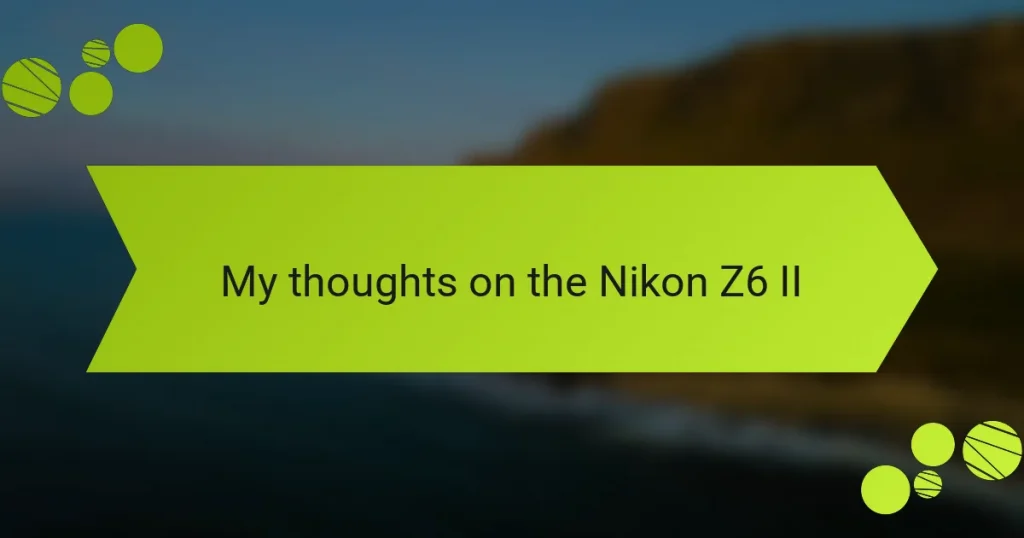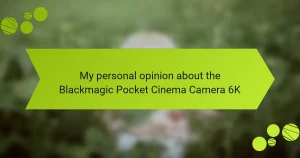Key takeaways
- Nikon Z6 II features a 24.5 MP full-frame sensor, dual card slots, and improved autofocus, enhancing performance for both enthusiasts and professionals.
- Offers high continuous shooting speed (up to 14 fps) and 4K video capabilities, making it versatile for both photography and videography.
- Exceptional low-light performance and robust build quality, ideal for outdoor and varied shooting conditions.
- Notable drawbacks include the lack of a fully articulated touchscreen and moderate battery life, making extra batteries advisable for long shoots.

Overview of Nikon Z6 II
The Nikon Z6 II impresses with its blend of performance and versatility, making it a compelling choice for both enthusiasts and professionals. With dual card slots, it addresses one of the main criticisms of its predecessor, ensuring I never miss a crucial shot. Have you ever been on a shoot, only to worry about storage? This feature gives me a sense of security.
The camera’s 24.5 MP full-frame sensor offers stunning image quality and low-light performance that’s truly remarkable. I still remember the first time I captured a stunning sunset with it—the colors were so vibrant that it felt like I was reliving the moment. There’s something magical about seeing your vision come to life through the lens, isn’t there?
Autofocus capabilities have also been significantly improved, boasting 273 points that make capturing fast-moving subjects much easier. I often find myself shooting sporting events, and the Z6 II keeps pace incredibly well. Can you think of a shoot where you missed the perfect moment? With this camera, that’s less likely to happen.
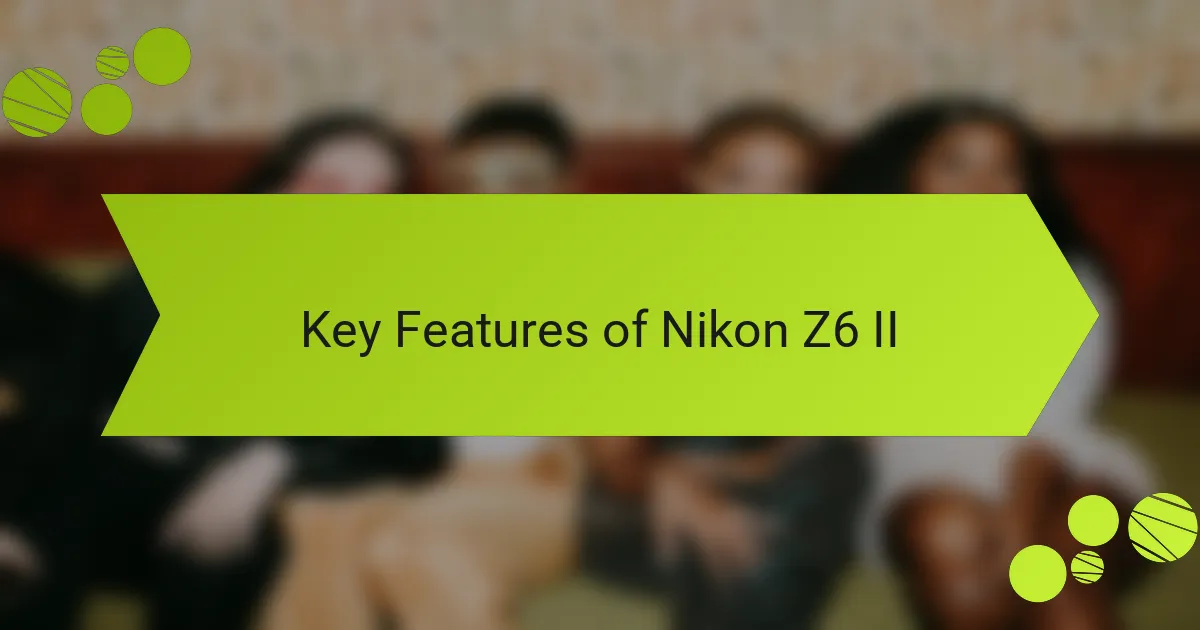
Key Features of Nikon Z6 II
The Nikon Z6 II is packed with impressive features, but one that stands out for me is its remarkable continuous shooting speed. With a burst rate of up to 14 frames per second, it enables me to seize action shots like never before. I recall a moment at a fast-paced sports event where every frame captured the thrill of the game—it’s exhilarating to know I won’t miss a beat.
The ability to shoot 4K video at 60p is another game-changer. I love experimenting with videography, and the level of detail and dynamic range in my footage has really elevated my projects. Have you ever wished your camera could just do a bit more? The Z6 II truly delivers when it comes to versatility in both stills and video.
Battery life, too, deserves a mention; it’s designed for extended shoots. The EN-EL15c battery provides a good amount of life, allowing me to focus on capturing moments without frequent interruptions. There’s nothing worse than running low on power mid-shoot—wouldn’t you agree? With the Z6 II, I feel empowered to immerse myself fully in the experience.
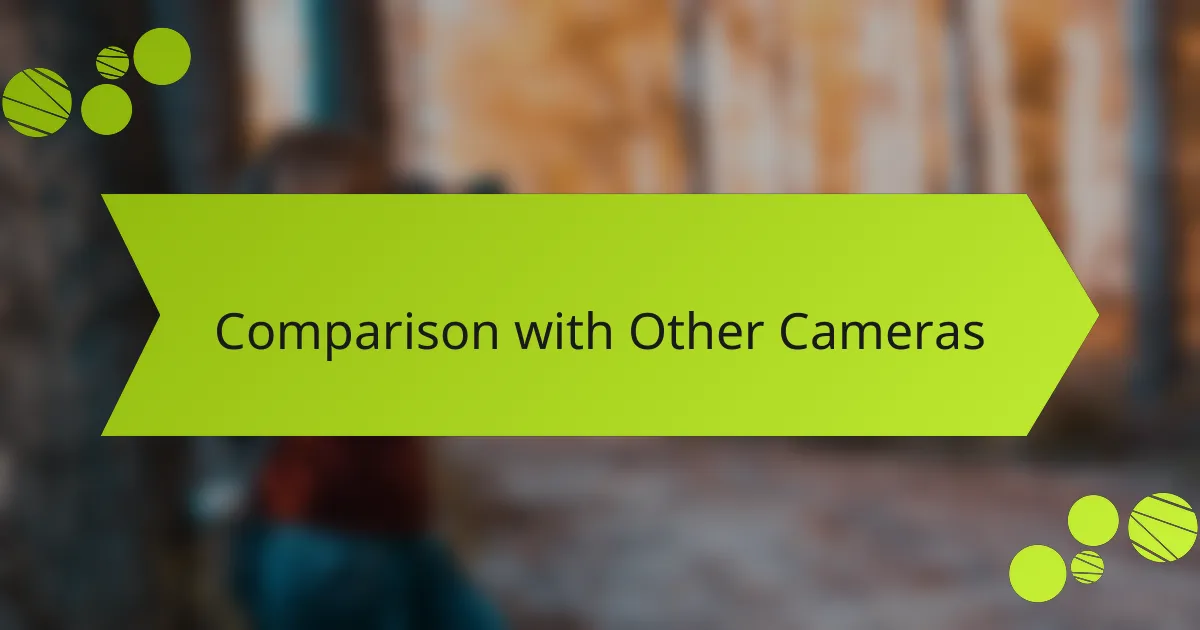
Comparison with Other Cameras
When comparing the Nikon Z6 II to cameras like the Sony A7 III, I find both have a lot to offer, but their autofocus systems tend to define their use cases. While the A7 III has a slightly better autofocus in low-light conditions, the Z6 II shines with its dual card slots and improved burst shooting capabilities, which I greatly appreciate during high-paced events. Have you ever felt the tension of waiting for your camera to lock focus in a dimly lit venue? Knowing my Z6 II can handle that pressure gives me a sense of confidence.
Looking at the Canon EOS R6, I see both strengths and weaknesses. The R6 offers fantastic image stabilization, which is excellent for handheld shooting, but I often lean towards the Z6 II for its battery life and the handling of video features during long shoots. Have you ever faced the frustration of a camera dying when you’re on the verge of capturing a memorable moment? With the Nikon, that worry is significantly reduced, allowing me to focus more on creativity.
It’s interesting to note how the Z6 II stacks against newer models like the Canon R7 or even the Fujifilm X-T4. While both these cameras are solid in their own right, I find the Z6 II’s full-frame sensor provides a depth of field that’s hard to replicate. I can’t help but reminisce about those dreamy portraits I’ve captured—moments that turned out beautifully thanks to that rich sensor. Have you ever seen a photo that just took your breath away? For me, those moments are precisely why I chose the Nikon Z6 II.
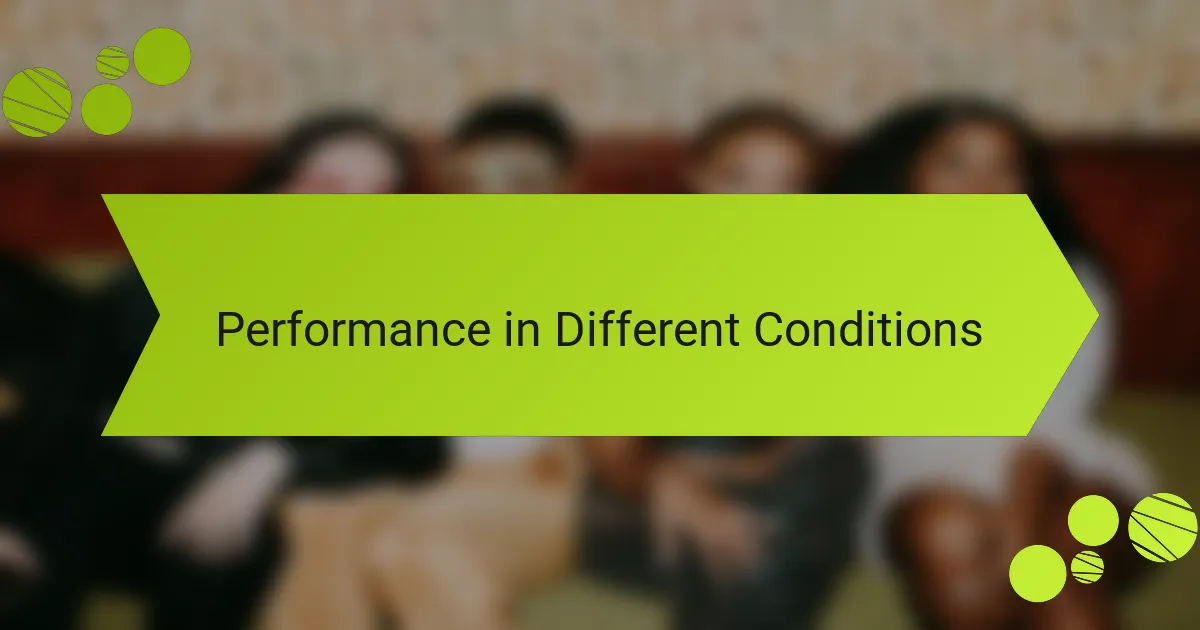
Performance in Different Conditions
When it comes to low-light performance, the Nikon Z6 II truly shines. I remember a night shoot at an event where the lighting was less than ideal. As I adjusted my settings, I was pleasantly surprised by how well it handled noise at higher ISO levels. Did you ever shoot in low light only to be disappointed by grainy images? With the Z6 II, I felt confident that I could capture the ambiance without compromising quality.
In bright daylight, the Z6 II performs admirably as well. I once took it along to a seaside adventure, capturing the vibrant blues of the ocean and the vivid greens of the landscape. I found that the dynamic range of the sensor helped retain details in both highlights and shadows exceptionally well. Have you ever struggled to get the perfect exposure in harsh sunlight? With the Z6 II, that is one less thing to worry about.
Weather resistance is another notable feature that has impressed me during outdoor shoots. While hiking in unpredictable weather, I was relieved to know my gear could withstand the elements. Have you ever felt anxiety over rain or dust compromising your equipment? The rugged build of the Z6 II allows me to focus on my photography, regardless of the conditions.
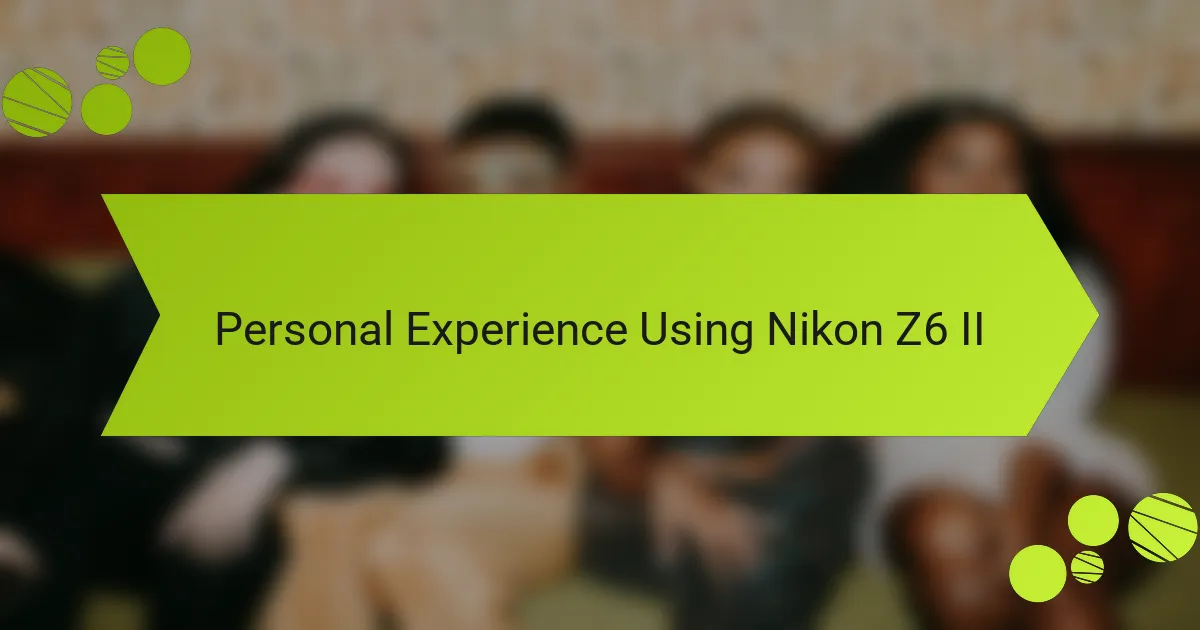
Personal Experience Using Nikon Z6 II
The Nikon Z6 II has truly been a game-changer for my photography. I remember taking it out for a sunset shoot and being blown away by how well it handled the dynamic range. The colors popped beautifully, and there was an impressive level of detail even in the shadows, which I found quite exhilarating.
From my experience, here are some standout features that make the Nikon Z6 II a joy to use:
– Dual EXPEED 6 Processors: This means faster performance and better low-light capabilities, which I’ve noticed during evening and indoor shoots.
– In-Body Image Stabilization (IBIS): It makes a significant difference when shooting handheld; I felt confident capturing sharp images without a tripod.
– Improved Autofocus: The eye-detection feature is particularly remarkable. I’ve captured some breathtaking portraits thanks to its reliability in tracking my subjects.
– Robust Build Quality: I appreciate how weather-sealed it is; it allows me to venture out in varied conditions without second-guessing my gear.
– User-Friendly Interface: The menu system is intuitive, making adjustments on the fly smooth and hassle-free during shoots.
These features have not only enhanced my technical ability but also deepened my passion for capturing moments.
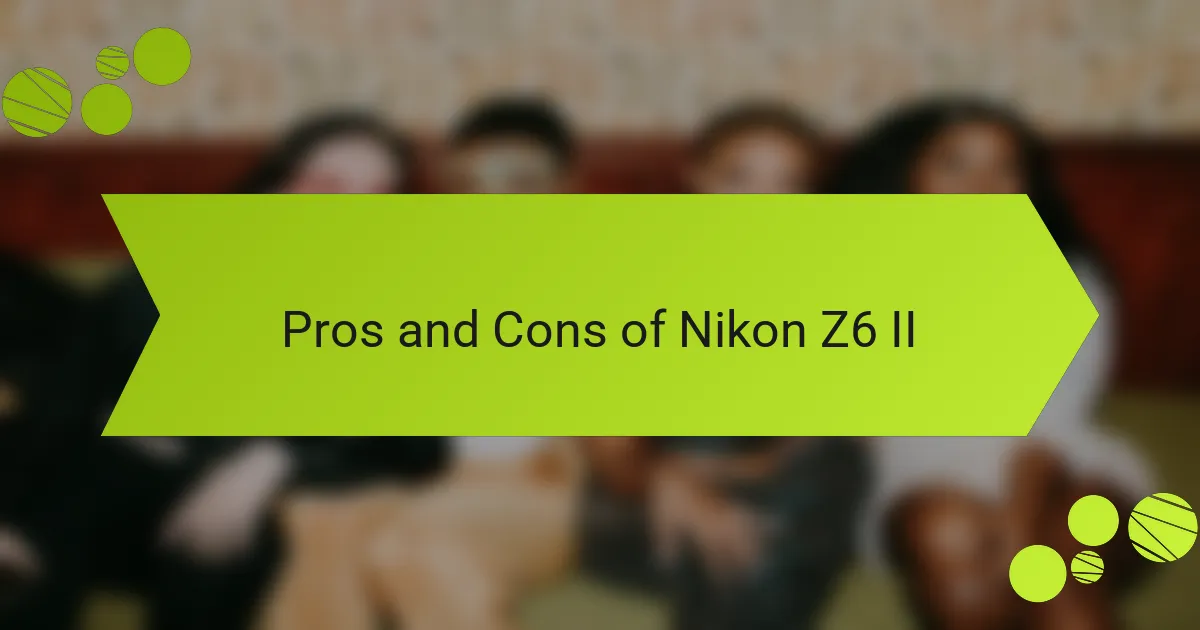
Pros and Cons of Nikon Z6 II
The Nikon Z6 II presents a compelling mix of strengths and a few weaknesses that photographers should consider. On the positive side, I find its robust build and exceptional low-light performance to be standout features that enhance shooting comfort and versatility. However, the absence of a fully articulated touchscreen can be a drawback for some, particularly when composing shots from challenging angles.
When I first used the Z6 II, I was impressed by its continuous autofocus capabilities, which made tracking moving subjects much easier. On the flip side, while the battery life is decent, it’s not outstanding, and I occasionally found myself needing to carry an extra battery for long shoots. Ultimately, weighing these aspects can help potential users decide if this camera meets their needs.
| Pros | Cons |
|---|---|
| Exceptional low-light performance | No fully articulated touchscreen |
| Robust build quality | Battery life could be better |
| Fast and accurate autofocus | Higher price point compared to competitors |
